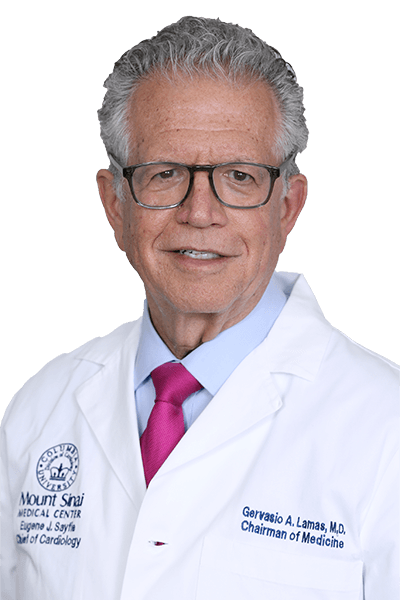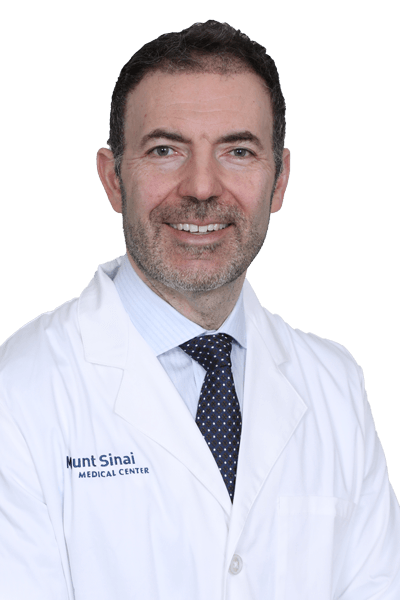Catheter Interventions
The Barry B. Siadat Family Heart Institute treats more patients for cardiovascular disease than any other hospital in South Florida, making it a leading choice for cardiac patients not only from Florida, but from around the world. In fact, our surgeons are the most experienced in the region performing minimally invasive heart procedures that utilize catheter-based interventions.
Armed with advanced technology, skilled practitioners, and access to the newest research, patients who come to Mount Sinai can take comfort in knowing we have the best heart attack survival rate in Florida* and the best cardiac surgery survival rate in Florida among hospitals that perform a high volume of complex cases.*
What Is Cardiac Catheterization?
Cardiac catheterizations refer to a group of procedures that are performed in Mount Sinai’s state-of-the-art cath lab. During these procedures, your Mount Sinai cardiovascular care team inserts a thin, hollow tube called a catheter into arteries or veins in your leg or arm and threads it into the heart. At Mount Sinai, we seek to utilize the radial artery in the arm whenever possible, because this approach reduces recovery time for our patients.
Our Approach
Interventional cardiology has evolved rapidly – and Mount Sinai has led the way. In addition to performing hundreds of procedures each year, we coordinate and participate in groundbreaking clinical trials that continue to advance the development of life-saving procedures.
Mount Sinai’s team of interventional cardiologists performs cardiac catherization for diagnostic purposes to evaluate blood flow to the heart and within the heart and to evaluate the heart’s ability to function properly.
We also use cardiac catheterization to perform procedures. We call these catheter-based approaches “endovascular procedures,” and we use them to open blocked arteries, correct structural heart defects, and repair damaged heart valves, as well as a number of interventions that can all be performed without incisions in the chest.
Vascular Interventions
Vascular disease refers to the conditions that affect the network of blood vessels that carry blood throughout the body. Vascular intervention procedures are used to open blocked arteries, repair arteries that have weakened or bulged outward into an aneurysm, and repair vessels that have begun to tear or dissect.
Most catheter procedures at the Barry B. Siadat Family Heart Institute to address vascular conditions are pre-scheduled and performed in an outpatient setting, with local anesthetic and light sedation. However, in emergencies, like when a patient arrives at the emergency department having a heart attack, we can spring into action and rush the patient to the cath lab and open blocked arteries in less than 60 minutes.
Vascular interventions using catheter procedures can be applied to vessels anywhere in the body, including those in the neck, legs, ankles, arms, and abdomen. At Mount Sinai, we frequently perform the following procedures in our cath lab to correct problems that occur within patients’ blood vessels:
Angioplasty & Stents
Angioplasty is a commonly performed, minimally invasive interventional method to open blocked arteries. We use a thin tube or catheter and insert the catheter through a vein in your groin or at your wrist. Then, your Mount Sinai cardiovascular care team threads the catheter to the blockage. Once the catheter is positioned inside the artery at the blocked part, we inflate a tiny balloon at the end of the catheter. The balloon spreads open, or dilates, the artery and compresses the blockage – comprised of plaque – to increase blood flow. Finally, your Mount Sinai physician inserts a stent, which is a small rigid tube, to prevent the artery from becoming blocked again.
Arterial Thrombectomy
Arterial thrombectomy is a procedure your Mount Sinai interventional cardiologist performs to remove a blood clot, which is blood that has thickened and become partially solidified. Clots inside an artery can occur suddenly and can cause pain. We use a thin tube, or catheter, and insert the catheter through a vein in your groin or at your wrist. Then, your Mount Sinai cardiovascular care team threads the catheter to the blood clot. Once the catheter is positioned inside the artery where the clot is located, we use a needle to draw the clot into the tube, remove it, and restore blood flow.
Atherectomy
This non-surgical intervention removes plaque by inserting a thin tube or catheter into an artery that is partially blocked. The catheter is outfitted with a tiny drill or sharp blade at the end. We insert the catheter through a vein in your groin or at your wrist. Then, your Mount Sinai cardiovascular care team threads the catheter to the part of the artery where the blockage is located. Once the catheter is positioned inside the artery at the point of the blockage, we use the drill or blade to break up the plaque. In some cases, we let the broken pieces of plaque flow through the bloodstream, and in other cases, we use suction to pull the plaque into the catheter.
At Mount Sinai, we also use a laser option to vaporize the plaque and smooth the lining of the vessel. This treatment is sometimes used in conjunction with a balloon.
Heart & Valve Interventions
At Mount Sinai, we use our state-of-the-art cath lab to address heart disease and valve conditions without the need for open heart surgery. Using these catheter-based interventions, we’re able to help patients who might otherwise require invasive surgeries with long recoveries. Instead, these patients can often recover at home with far less pain and less risk.
Balloon Valvuloplasty
Balloon valvuloplasty is a surgical procedure used to open a narrow heart valve. During balloon valvuloplasty at Mount Sinai, we use a thin tube, or catheter, and insert the catheter through a vein in your groin or at your wrist. Then, your Mount Sinai cardiovascular care team threads the catheter to the affected valve in your heart. Once the catheter is positioned into the narrowed valve opening, your interventional cardiologist inflates the balloon to separate the valve leaflets. After the balloon has opened the heart’s valve, the catheter and balloon are removed.
This procedure is also known as percutaneous balloon valvuloplasty, or a balloon enlargement of a narrowed heart valve.
Coronary Angioplasty
When plaque builds up inside the arteries of the heart, the artery can become partially or completely blocked. And if those blockages prevent blood from flowing to the heart, a heart attack can happen. Coronary angioplasty can open the blocked arteries before a heart attack can happen and before the need for more serious procedures like coronary bypass surgery.
During coronary angioplasty at Mount Sinai, we use a thin tube or catheter and insert the catheter through a vein in your groin or at your wrist. Then, your Mount Sinai cardiovascular care team threads the catheter to the affected artery in your heart. Once the catheter is positioned inside the artery at the blocked part, we inflate a tiny balloon at the end of the catheter. The balloon spreads open, or dilates, the artery and compresses the blockage – comprised of plaque – to increase blood flow. Finally, your Mount Sinai physician inserts a stent, which is a small rigid tube, to prevent the artery from becoming blocked again.
At Mount Sinai, we use coronary angioplasty to reduce chest pain due to a lack of sufficient blood flow to the heart. A coronary angioplasty can also reduce potential damage to the heart muscle after someone suffers a heart attack.
Coronary Atherectomy
Coronary atherectomy, or rotablation, is a type of angioplasty that we perform at the Barry B. Siadat Family Heart Institute to remove plaque inside the arteries of the heart. We insert a thin tube, or catheter, through a vein in your groin or at your wrist. Then, your Mount Sinai cardiovascular care team threads the catheter to the part of the artery in the heart where the blockage is located. Once the catheter is positioned inside the heart at the point of the blockage, we use a tiny drill or blade positioned at the tip of the catheter to break up the plaque. In some cases, we let the broken pieces of plaque flow through the bloodstream, and in other cases, we use suction to pull the plaque into the catheter.
At Mount Sinai, we also use a laser option to vaporize the plaque and smooth the lining of the vessel.
MitraClip and Edwards PASCAL Therapy
MitraClip and Edwards PASCAL Therapy are nonsurgical treatments for mitral regurgitation. This is a condition where blood flows backward into the heart because the heart’s mitral valve does not close tightly.
MitraClip repairs the heart’s mitral valve without the need for an invasive surgical procedure. The device is delivered to the heart using a catheter, or a small tube, through the femoral vein, which is a blood vessel in the leg. The heart beats normally during the procedure, and a heart-lung bypass machine is not required. The treatment works by clipping together a portion of the leaflets, or tissue flaps, of the mitral valve to reduce the backflow of blood.
Like MitraClip Therapy, Edwards PASCAL Therapy is a nonsurgical treatment for mitral regurgitation. This system uses paddles and a spacer to clip together the leaflets.
Patients who have the MitraClip or Edwards PASCAL Therapy treatment typically experience short recovery times and short hospital stays, an average of 2-3 days.
Percutaneous Heart Valve Replacement (Edwards or CoreValve® Systems)
Some patients with diseased valves in their heart can have their heart valves replaced without surgery, using an artificial valve and special devices made by Edwards or CoreValve®. These non-surgical approaches are especially helpful for patients who may not be good candidates for heart surgery – either because of their age or other health conditions.
Percutaneous heart valve replacement uses a special type of catheter equipped with an artificial valve, called a transcatheter valve, inserted through an artery in your groin or under the collarbone. Once inserted, your Mount Sinai cardiovascular care team threads the catheter to the heart and positions it where the new valve is needed. Once in place, the transcatheter valve expands into the place of the original valve and takes over its function.
For patients who have had prior valve replacement surgery, they can have a transcatheter valve placed into the failing surgical valve to fix narrowing or valve leaks. Patients who replace diseased valves in their heart using this non-surgical approach often see significant improvements in their quality of life. In addition, they have fewer complications, shorter hospital stays, and quicker recoveries than patients who have valve replacement surgery.
Mount Sinai was one of the first hospitals to perform heart valve replacement without surgery and is among the most experienced hospitals using this technique.
Structural Heart Disease Treatments
Structural heart disease includes congenital heart defects, which are defects present at birth. In addition to congenital heart defects, structural heart disease includes abnormalities of the valves and vessels of the heart wall. These may develop through wear and tear, or through disease progression.
Common structural heart defects include “holes” between the chambers of the heart, a pinched or constricted aorta (the main artery that carries blood from the heart), abnormal connections in the heart, or leaky or narrowed valves. Other issues include an atrial septal defect (ASD), which is a hole in the wall, or septum, that separates the top two chambers of the heart. A patent foramen ovale (PFO) is a flap-like hole in the wall that separates the upper two chambers of the heart. Cardiac catheterization techniques for these include procedures that focus on closing the holes.
Our Physicians
Gervasio A Lamas, MD
Chairman of Medicine
Eugene J. Sayfie, M.D. Chief of Cardiology
Co-Director, Barry B. Siadat Family Heart Institute
Professor at the Columbia University Division of Cardiology at Mount Sinai Medical Center
- Cardiology
- Concierge Medicine
- Mount Sinai Medical Center (Main Campus)
- 305.674.2998
Eric S. Weiss, MD, MPH
President of Cardiovascular & Thoracic Surgery (CVTS) at Mount Sinai Medical Center
Co-Director of Valve Surgery at Mount Sinai Medical Center
- Cardiology
- Cardiac Surgery
- Thoracic & Cardiovascular Surgery
- Mount Sinai Medical Center (Main Campus)
- 305.674.2780
Steve Xydas, MD
Chief of the Columbia University Division of Cardiac Surgery
Co-Director, Mount Sinai Heart Institute
Co-Director, Aortic Center
- Cardiology
- Cardiac Surgery
- Robotic Surgery
- Aortic Aneurysm Repair
- Minimally Invasive Valve Surgery
- Thoracic & Cardiovascular Surgery
- Mount Sinai Medical Center (Main Campus)
- 305.674.2121
Alfonso O Tolentino, MD
Vice Chairman of Medicine
Director of Electrocardiography Laboratory at the Columbia Division of Cardiology at Mount Sinai Medical Center
Assistant Professor of Medicine at the Columbia University Division of Cardiology at Mount Sinai Medical Center
- Cardiology
- Mount Sinai Medical Center (Main Campus)
- 305.674.2690
Roy F Williams, MD
Chief, Divison of Thoracic Surgery
- Cardiology
- Robotic Surgery
- Thoracic & Cardiovascular Surgery
- Lung Cancer
- Mount Sinai Medical Center (Main Campus)
- 305.674.2121
Nirat Beohar, MD
Director, Cardiac Catheterization Laboratory
Director, Interventional Cardiology Fellowship Program
Medical Director, Structural Heart Disease Program
Professor at the Columbia University Division of Cardiology at Mount Sinai Medical Center
- Interventional Cardiology
- Cardiology
- Mount Sinai Medical Center (Main Campus)
- 305.674.2690







